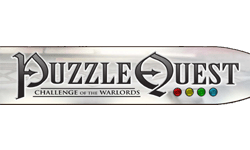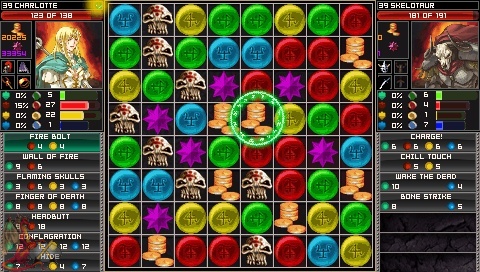|
|

|
PLATFORM
|
Xbox Live Arcade
|
PUZZLE SYSTEM
|

|
INTERACTION
|

|
ORIGINALITY
|

|
STORY
|

|
MUSIC & SOUND
|

|
VISUALS
|

|
CHALLENGE
|
Moderate
|
COMPLETION TIME
|
20-40 Hours
|
|
OVERALL

|
+ Addictive game play
+ Solid expansion content
+ Surprisingly solid story
- AI "cheats"
- Move indicator useless
- Conveniently random spawns
|
Click here for scoring definitions
|
|
|
As the RPG genre becomes more expansive and the debate for what really is or is not qualified to be titled a roleplaying game heats up, developers are getting creative in what can be stirred into the RPG formula -- however it is defined -- to make interesting and quirky titles. Puzzles, both logical and physical, have been in RPGs for ages, but never quite the way Puzzle Quest: Challenge of the Warlords does. By replacing combat with a puzzle system reminiscent of Bejewelled, the game, though repetitive, is hypnotically addictive and manages to overcome most of its faults to round out to be a slightly above average game. This review was written after playing the XBLA version, which also includes the expansion content entitled Puzzle Quest: Challenge of the Warlords - Revenge of the Plague Lord. Though brandishing an unwieldy title, the expansion content adds a lot to the game play and is able to round out some of the holes the standalone title had.
Before any puzzling can begin, players must first choose a class. Each will learn different spells as they grow and have different stats, so taking some time to experiment with each may help a player find their niche. Two additional classes were added with Plague Lord, so even those that may have played the game on a previous system will find something intriguing to dabble with. As the character levels, they must decide where to place their precious stat points: Morale, which increases HP; Cunning, which increases experience and gold earned; Battle, which increases damage inflicted; or a Mastery skill for each of the four elements, which dictates among other details how much mana of that colour can be stored while in combat.
An agile mind over twitch reflexes are needed to compete on the battlefield. Board pieces include purple experience stars, gold coins, damage-inflicting skulls, and the ever crucial four colours of mana: red, yellow, green and blue. Aligning three or more gems will cause them to disappear, releasing their benefits. Mana is pooled and can be used to unleash a large variety of spells, including both simple damage spells as well as abilities which stun the opponent or heal the caster. How much mana a player can accrue is based upon their mastery stat for that element; the higher the mastery, the more mana that can be stored. The round is over when one side loses their hit points. If a player is not victorious, they are repelled to the closest landmark, earning little to no gold or experience. With victory comes copious experience and gold and the way forward is then clear.
 Combat
Combat
|
|
Puzzle Quest has a simple but effective equipment system. Players may wear items in four slots: weapon, helm, armour, and accessory. It's important to keep a variety of these pieces on hand as some bosses can have their difficulty eased slightly by equipping the right defences. These items may be purchased, crafted, or acquired by completing quests and killing important storyline enemies. In order to craft items, players need to seek out Runes hidden in most map locations and defeat the Rune keeper. Though gathering runes is entirely optional, the best equipment from the game comes from these Runes so those seeking to make their struggle easier may find it is time well invested. Sadly, no amount of detail can truly capture the addictive quality of the puzzle system.
As the player progresses, they have the option to manage a citadel inside their home city. This citadel may be built up with several improvements, most notably a stable, a mage tower, and a temple. The stable allows for the capture of mounts, which bestow some riding speed and an ability upon the rider. The mage tower allows the player to learn many of the powerful spells foes will wield against them. Praying at the temple, for an increasing fee, will allow the player to increase their stats. Much of this information is accessible through the touch of a button. Menus are efficiently organized to display the most information in the fewest words. Many graphics are used in the menus to represent everything from the number of spells a captured enemy has to the bonuses a companion bestows upon the player.
The music and sound effects are nicely done, filling in a background ambiance without being intrusive or obnoxious. While not particularly memorable outside of the game, they are able to give the game a variety of emotions from urgency to humour without being jarring. The graphics have been given a dusting off and are much improved for the 360 version, owing to both time and the system's larger screen capacity. Much like the music they are well done, if at first glance a little unremarkable. The game's originality is also somewhat difficult to gauge; puzzles in an RPG is nothing groundbreaking, though nothing like this is common. The story is a little cheesy at times but in no way a stereotype, especially considering the optional content.
 Story Scene
Story Scene
|
|
The story of Challenge of the Warlords is mostly linear. An undead invasion is coming, Lord Bane was behind the last one, and it's up to the hero to discover what's going on this time. The player has the option as they go along in the story to pick up a variety of companions (NPCs while bestow minor boons during combat), and the choices made do impact who will or will not be available to call upon. With the addition of Revenge of the Plague Lord additional expansion story and content was inserted into the game at a variety of stages -- in fact, none of it occurs after the original end boss battle as most expansions do. It also fills in some of the minor plot holes the standalone game had, and provides an additional half dozen companions, filling some much-needed roles. While the new story content is entirely optional it's an excellent addition to the main story and players who have the opportunity to experience it won't regret taking the time to do so.
Throughout most of the game, the difficulty remains quite moderate; though bosses are significantly harder then the normal rabble, often requiring repeated tries to muddle through which equipment and spells work best against them -- and barring any particularly "lucky" streaks the opponent may get. The difficulty of the game does increase over time, with monsters getting increasingly sly and their abilities being just a little meaner each time the player progresses to a new chapter. Above all, flexibility will win the day -- and sometimes a bullheaded stubbornness is necessary as well. For players sailing through on the main storyline only, the game can be completed in as little as twenty hours. Those wishing to explore all of the optional content will find their clocks creeping towards and likely over forty hours of game play.
Puzzle Quest is a nice interlude in a genre that frequently takes itself far too seriously. Though a weak story and middling visuals and music don't help the game, its mysteriously addictive qualities will likely find players coming back to playing again and again, even after the main storyline is completed. For those that enjoy fast and furious game play, this will likely be unappealing. For those that are interested in trying something a little different this is definitely worth the time and attention of a second look. Considering the game is available in nearly a dozen ways including consoles, handhelds, downloads and mobile devices, anyone interested in procuring a copy should find no barriers for acquisition.
Review Archives
|









